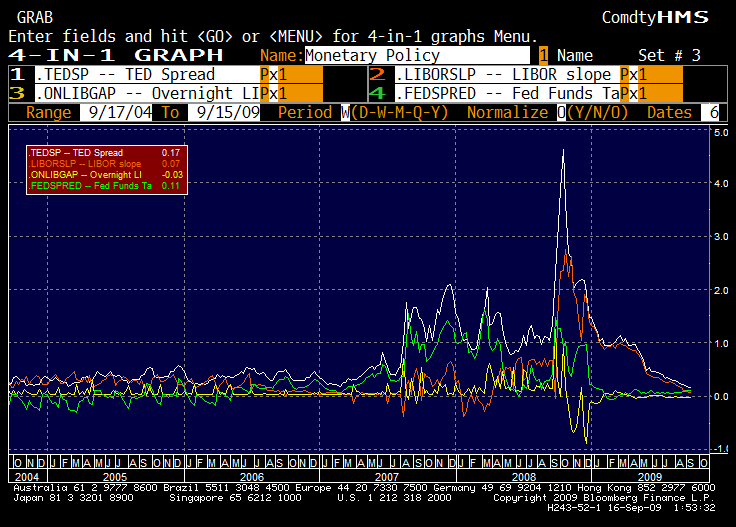Okay, I am going out on a limb here, so please understand that what I am saying is a bit of an experiment.? When quantitative easing was originally done in Japan, it was after:
- a credit-fueled expansion that pushed the stock and real estate markets to new heights, which have not been seen for 19 years.
- productive capacity was built up that the rest of the world would not need.
- anticipated returns on equity for investment projects were in the low single digits.
Now, during the time of quantitative easing, the following things happened:
- money market rates were near zero.
- relatively few private investors wanted to borrow money for investments to expand productive capacity.
- government deficits expanded dramatically in a futile attempt to simulate an over-indebted economy.
- Speculators borrowed money in yen in order to do carry trades.? They borrowed the surplus yen from the quantitative easing, and used the leverage to speculate on higher-yielding debt.? This had little benefit for the average person in Japan, though many played the carry trade game internally, buying investments denominated in Australian, New Zealand, or US Dollars.
Back to the present, and back to the US.? Short-term borrowing rates have been falling, as there is a lack of demand to borrow short-term.? Contrast that with one year ago, where there was no lack of demand to borrow short-term, but no willingness to lend.
An amazing change indeed, but much of it stems from a lack of demand for short-term borrowing. Some attribute the low TED (3-month Eurodollar less Treasury yield) spread to risk-seeking, but I think that banks don’t have many uses for surplus cash now.
As it is, with low US Dollar LIBOR lending rates, it makes the US Dollar a honeypot for speculators.? Borrow in Dollars, invest in your favorite higher yielding currency, or in higher credit risk instruments.? For the foreign currency trade, the added kick is that the US Dollar may decline in value.? That said, many said the same would happen to the yen; that it would decline in value, and it did not.? I have many reasons to think why the Dollar will decline, but the carry trade argument goes the other way for me.
Now, maybe the excess liquidity is fostering day traders as well.? We saw the same phenomenon in 1999-2000.? The liquidity should not have leaked out, but it did, and to those that would only speculate.
So what is the Fed doing?? Is it ending quantitative easing?? It seems not.? They will buy mortgages until they reach their preannounced limit, most likely.? That said, the Treasury might reduce funding to the Fed.? They see less need to fund the Fed, though that will force the Fed to decide how large it wants its balance sheet to be in a time of crisis.
Here’s my concern — having carry traders absorb excess liquidity that the Fed has put out is a waste of Fed resources, and indicates that Fed policy is too loose.? Don’t buy more mortgages and agencies, and consider selling bonds back in to the market.? Let short-term rates rise to reflect the true scarcity of short-term ways to profit.? Let savers earn some money — there is no benefit to having monetary policy so loose.
To summarize: Japan did not benefit from many years of quantitative easing, but it provided a lot of fuel for carry trades around the world until most of them blew up over the last two years.? It seems to me that excess liquidity created by the Fed is going the same way now, because consumers and businesses don’t want to borrow to the same degree as they did during the boom phase.
It will take a long time for balance sheets to heal.? It depends upon the rates of debt forgiveness/compromise, and paying it down.? During the Great Depression, Debt/GDP peaked several years after the Depression started, and after the peak it took about ten years for it to come down to a more normal level in 1941.? I suspect that we will go through this same process again, before the economy grows robustly as it did post-1941, regardless of what the Fed and Treasury do.


Well put, David. I used to think the Fed was either stupid or corrupt, but now I’m beginning to think that they are just bureaucrats afraid to do anything different that they can be blamed for. It’s the equivalent of a portfolio manager buying IBM–nobody ever got fired for buying IBM. No one at the Fed ever got fired for lowering interest rates–when it blows up again they can throw up their hands and say they did the best they could–or that they could fix the problem this time if only they were given more authority.
On the other hand, if they lean against the speculation, they will be blamed for “stunting the recovery” or worse. In Bernancke’s mind I’m sure there is nothing worse than repeating the tightening of 1937–he spend his whole career fighting a war as out of date as the cavalry-breakout obsessed generals of World War I. The only tragedy is the damage his “leadership” will cause.
David, this an insightful take. Thanks for expressing it so well.